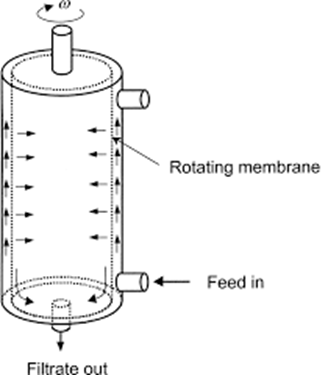TAGGED: #fluent-#cfd-#ansys, #multiphase_models, fluids
-
-
May 2, 2025 at 9:09 am
srath9
SubscriberHello everyone,
I am trying to simulate the following system. The membrane has 4um pores with porosity ~ 0.8. It is rotating which facilitates the removal of filtrate and concentrating the solids (~12um) within the annular region. After the packing of solids reaches (target of 12%), the feed is stopped. In real experiments, the solids don't pass through the membrane and are accumulated in the annular region.
The feed contains water-like media and solids (VF~1-2%). The feed flow rate is variable, so the flow can be turbulent/laminar at inlet.
Approach: Simulating porous media with mixture model, enabling high resistance (~1e18 for viscous resistance coefficients) for solids so that they don't pass through the porous membrane.
Challenges: I am able to converge (with residuals <1e-3) within reasonable time, but I see some solids escape at the outlet as they reach close to the top wall. To prevent this, when I increase the resistance, convergence becomes an issue (may due to very high pressure loss).
Is the approach correct? What improvements shall I consider?
Thank you!
-
May 2, 2025 at 10:35 am
Rob
Forum ModeratorPorous media will slow but not stop particles in the Eulerian phase which also allows phase specific resistance coefficients. With Mixture model I think the resistance is for the all phases so you're also going to be changing the air flow by messing with the resistance settings.
If you need to model the cake then you either don't worry too much about some mass escaping or look at using Rocky for the solids. There are some UDF options, but they're often no better, and not something I can explain on the Forum.
If you just want to represent the cake as resistance and particle loading is within the range then DPM, Porous Jump (to trap particles and mimic the cake using UDFs) plus Porous Media makes a good model. Again, not something I can explain on the Forum in further detail.
-
May 2, 2025 at 12:31 pm
srath9
SubscriberHi Rob,
Thanks for the reply.
- I checked the mixture model and was able to define resistances for each phase separately. Also, I chose mixture model because the volume fractiion is very low at start (<1%) which gradually forms a cake or accumulates increasing the volume fraction to ~12%. I will also check with Eulerian model.
- I can work with some solids escaping but because of the resistances I used, I could see the accumulation at start but there is a consistent loss at the very top.
- I also checked perforated plate BC, which didn't work out either. The model assumes mass balance across the plate, which is not true for the real scenario (as there is solids accumulation).
- I checked porous jump as standalone model, but didn't use it earlier because the resistances become fixed for all phases. Though it didn't occur to me then, that it can be used together with porous media.
A follow-up question on the last point: What happens to the resistance values if porous jump plus porous media is used?
-
May 2, 2025 at 12:43 pm
Rob
Forum ModeratorMixture is similar to Eulerian, but with shared momentum & energy equations: Eulerian solves fields for each phase so costs more cpu but tends to be better in many cases.
If the solids begin to accumulate near the top and/or flow is very low you'll see leakage. Review how the resistance is calculated.
Perforated plate isn't suitable here. It's for walls with many holes and assigns a discharge effect so is used for blade cooling and combustor cans amongst other things.
PJ is often used with DPM to allow particles to be trapped. You can then assign resistance to the PJ to mimic the cake. The porous media remains "unblocked". The resistance is independent but the pressure drop is summed.
-
May 8, 2025 at 9:13 am
srath9
SubscriberThanks Rob. DPM with PJ (reflect BC) works fine. I could inject particles (along with continuous phase). I have good convergence and particle behaviour. However, the downside of this method is no. of particles. I have around 1e9-1e10 particles in the actual system, which is expensive to track via DPM method. I will keep working on this to see if I can build a representative model.
I also tried Eulerian, but was difficult to converge (even with very low timestep) as the solids fraction increased with time. I will modify some settings to see if I can make it work properly.
-
May 8, 2025 at 12:50 pm
Rob
Forum ModeratorHave a read up on Parcel Theory. No one tries to model the actual particle count: as you've found the numbers can be a little high.
Eulerian will form a cake, and the model is really designed for mobile granular flows, and not semi-static effects.
-
- You must be logged in to reply to this topic.



-
3597
-
1283
-
1117
-
1068
-
983

© 2025 Copyright ANSYS, Inc. All rights reserved.








